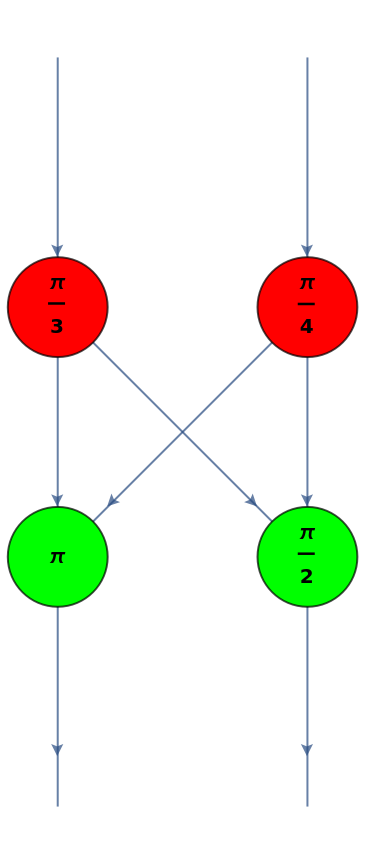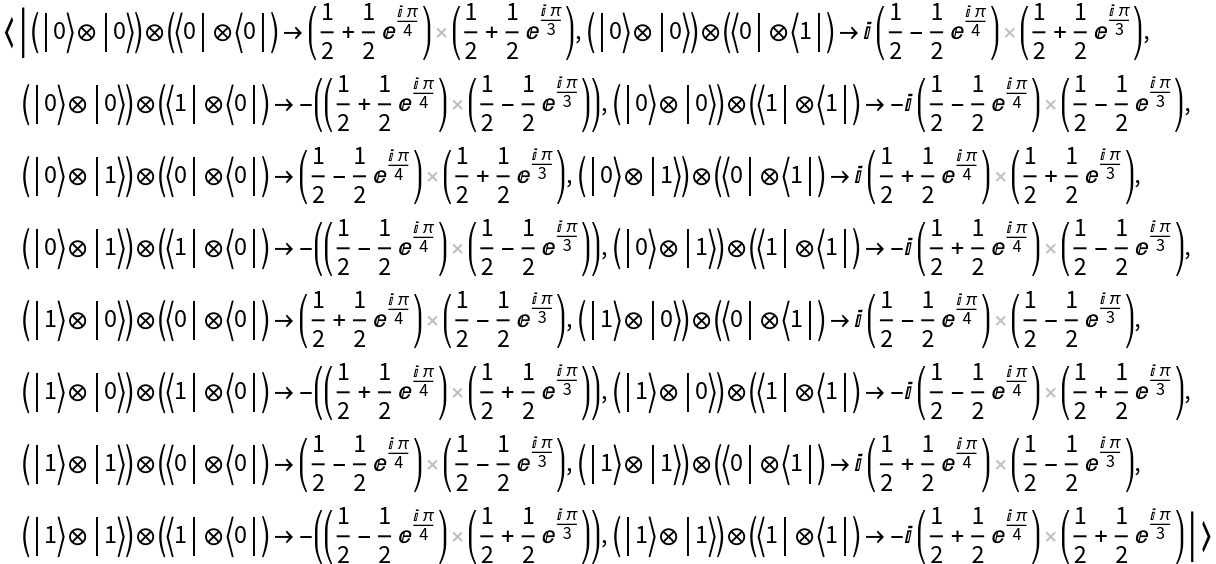Details
If ResourceFunction["ZXDiagramToQuantumDiscreteOperator"] succeeds in converting the specified ZXDiagramObject into a discrete quantum operator, it will return a QuantumDiscreteOperator object.
ResourceFunction["ZXDiagramToQuantumDiscreteOperator"] works by converting each sequential composition of Z-spider and X-spider generators into sequential compositions of rotations around the z axis and the x axis of the Bloch sphere, respectively, before eventually taking the tensor product of all such compositions to yield the desired QuantumDiscreteOperator.
The generators/spiders within the specified ZXDiagramObject may have arbitrary input and output arities.
In the resulting QuantumDiscreteOperator, the following properties are supported:
| "Operator" | association <|b11→e11,b12→e12,…|> of tensor products of basis names and matrix elements |
| "Basis" | which QuantumBasis the operator is defined with respect to |
| "Picture" | which quantum mechanical picture the operator is defined with respect to |
| "BasisElements" | list of basis elements bi |
| "MatrixRepresentation" | matrix representation mat of the operator |
| "OrderedMatrixRepresentation" | matrix representation adjusted according to the order of the operator, assuming an input state containing Max[order] qudits (subsystems) |
| {"OrderedMatrixRepresentation",n} | matrix representation adjusted according to the order of the operator, assuming an input state containing n qudits (subsystems) |
| "Arity" | arity of the operator |
| "Dimensions" | dimensionality of each qudit (subsystem) in the input state for the operator |
| "Order" | order in which the operator should be applied to qudits (subsystems) in the input state |
| "HermitianQ" | whether the operator is Hermitian (self-adjoint) |
| "UnitaryQ" | whether the operator is unitary (an automorphism of Hilbert space) |
| "Eigenvalues" | eigenvalues of the matrix representation of the operator |
| "Eigenvectors" | eigenvectors of the matrix representation of the operator |
| "Properties" | list of all property names |
The default convention is to name Z-spiders as z1,z2,…; X-spiders as x1,x2,…; black diamonds as d1,d2,…; inputs as i1,i2,…; outputs as o1,o2,…; etc.




![diagram = ResourceFunction[
"MakeZXDiagram"][{\[FormalCapitalZ][z1, 2, 2, Pi/2], \[FormalCapitalX][x, 2, 2, Pi/2], \[FormalCapitalZ][z2, 2, 2, Pi/2], \[FormalCapitalW][i1, z1], \[FormalCapitalW][z1, x], \[FormalCapitalW][x, z2], \[FormalCapitalW][z2, o1], \[FormalCapitalZ][z3, 2, 2, 0], \[FormalCapitalW][i2, z3], \[FormalCapitalW][z3, o2], \[FormalCapitalW][z3, z1]}]](https://www.wolframcloud.com/obj/resourcesystem/images/636/6367a913-ab38-4aea-8c40-4d50d0c1f735/6bd1626d5c343365.png)



![diagram2 = ResourceFunction[
"MakeZXDiagram"][{\[FormalCapitalZ][z1, 1, 1, Pi], \[FormalCapitalZ][z2, 1, 1, Pi/2], \[FormalCapitalX][x1, 1, 1, Pi/3], \[FormalCapitalX][x2, 1, 1, Pi/4], \[FormalCapitalW][i1,
x1], \[FormalCapitalW][i2, x2], \[FormalCapitalW][x1, z1], \[FormalCapitalW][x1, z2], \[FormalCapitalW][x2, z1], \[FormalCapitalW][x2, z2], \[FormalCapitalW][z1, o1], \[FormalCapitalW][z2, o2]}]](https://www.wolframcloud.com/obj/resourcesystem/images/636/6367a913-ab38-4aea-8c40-4d50d0c1f735/19f749247835ecf4.png)


